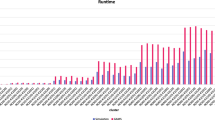Abstract
Because of an increase in population, the demand for coal has drastically risen with millions of tons of coal being imported annually through Indian ports. To accommodate with this rise in demand, there has been an increase in the concern over proper ship scheduling and effective stockyard management. This article focuses on these aspects, as well as train scheduling, in the context of coal imports in port terminals. The article employs two heuristic-based greedy construct algorithms to improve port terminal throughput capacity by minimizing the delay of ships in port terminal. Applicability and validity of the model is tested on the database of a port located along the east coast of India.












Similar content being viewed by others
References
Abdekhodaee, A., Dunstall, S., Ernst, A.T. and Lam, L. (2004) Integration of stockyard and rail network: A scheduling case study. In: Proceedings 5th Asia-Pacific Industrial Engineering and Management Systems Conference, Gold Coast, Australia, 12–15 December, pp. 25.5.1–25.5.17.
Ballis, A. and Golias, J. (2004) Towards the improvement of a combined transport chain performance. European Journal of Operational Research 152 (2): 420–436.
Bartlett, T. (1957) An algorithm for minimum number of transport units to maintain a fixed schedule. Naval Research Logistics Quarterly 4 (2): 139–149.
Boland, N., Gulczynski, D. and Savelsbergh, M. (2012) A stockyard planning problem. European Journal of Transportation and Logistics 1 (3): 197–236.
Cordeau, J.F., Gilbert, L., Luigi, M. and Gregorio, S. (2011) Optimizing yard assignment in an automotive transshipment terminal. European Journal of Operational Research 215 (1): 149–160.
He, S., Song, R. and Chaudhry, S.S. (2003) An integrated dispatching model for rail yards operations. Computers and Operations Research 30 (7): 939–966.
Imai, A., Zhang, J.-T., Nishimura, E. and Papadimitriou, S. (2007) The berth allocation problem with service time delay time objectives. Maritime Economics & Logistics 9 (4): 269–290.
Kim, K.H. and Park, K.T. (2003) Dynamic space allocation for temporary storage. International Journal of Systems Science 34 (1): 11–20.
Lee, L.H., Chew, E.P., Tan, K.C. and Han, Y. (2006) An optimization model for storage yard management in transshipment hubs. OR Spectrum 28 (4): 539–561.
Lodi, A., Martello, S. and Monaci, M. (2002) Two-dimensional packing problems: A survey. European Journal of Operational Research 141 (2): 241–252.
Meisel, F. and Beirwirth, C. (2008) Heuristics for the integration of crane productivity in the berth allocation problem. Transportation Research Part E 45 (1): 196–209.
Moorthy, R. and Teo, C.P. (2006) Berth management in container terminal: the template design problem. OR Spectrum 28 (4): 495–518.
Ng, J.W.C. and Mak, K.L. (2005) Yard crane scheduling in port container terminals. Applied Mathemtical Modelling 29 (3): 263–276.
Park, Y.M. and Kim, K.H. (2003) A scheduling method for berth and quay cranes. OR Spectrum 25 (1): 1–23.
Umang, N., Beirlaire, M. and Vacca, I. (2012) Exact and Heuristic Methods to Solve the Berth Allocation Problem in Bulk Ports. Technical Report, TRANSP-OR, Switzerland: Ecole Polytechnique Federale De Lusanne.
Welgama, P.S. and Oyston, R. (2003) Study of options to increase the throughput of the Hunter Valley coal chain. In: David A. Post (ed.) Proceedings of MODSIM 2003, Townsville, Australia, 14–17 July, pp. 1841–1846.
Zhang, C., Wan, Y.W., Liu, J. and Linn, R. (2002) Dynamic crane deployment in container storage yards. Transportation Research Part B 36 (6): 537–555.
Zhen, L., Chew, E.P. and Lee, L.H. (2011) An integrated model for berth template and yard template planning in transshipment hubs. Transportation Science 45 (4): 483–504.
Acknowledgements
We thank the reviewers and editor for their valuable comments and advices, which have contributed in improving the quality of the manuscript. Their questions and comments have aided us a lot in making the description elucidate to the readers. We would like to express our sincere gratitude to the reviewers and editor for contributing their valuable time in reviewing and improving the manuscript. Due to a confidentiality agreement, the name of the port could not be mentioned here, but all data and related information have been provided in confidence to the editor.
Author information
Authors and Affiliations
Rights and permissions
About this article
Cite this article
Babu, S., Pratap, S., Lahoti, G. et al. Minimizing delay of ships in bulk terminals by simultaneous ship scheduling, stockyard planning and train scheduling. Marit Econ Logist 17, 464–492 (2015). https://doi.org/10.1057/mel.2014.20
Published:
Issue Date:
DOI: https://doi.org/10.1057/mel.2014.20




